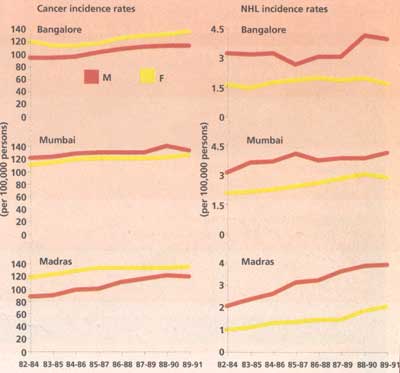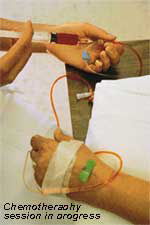The doctors said that this time they had caught
the recurrence so early that they were sure the 1994 treatment would get me back in
remission, but they were also certain the remission would not last even a year. I needed
something more definite, something with a higher probability of cure — “such
that you can live till 70 or beyond till only old age kills you”, as one of the
doctors who was very fond of me put it. She and others knocked their heads together and
came up with a solution: medicos in Paris were experimenting with bone marrow transplants
to cure nhl. “After we put you into remission, you must immediately go in for this
treatment,” they recommended. Bone marrow transplant is one the most invasive medical
procedures developed by modern science. I went through it in mid-1996 and hope that I have
finally gotten rid of the disease. That, however, is something that only time will tell.
Meanwhile, I will keep praying that some medical scientist somewhere, will continue to
look for a simpler, less horrifying and more definitive cure for this rare disease.

|
Incidental
Comparisons : Cancer and NHL Age-adjusted incidence rates and growth (bottom table) :
3-year running averages (1982-91)
|
| |
Cancer |
NHL |
| M |
F |
M |
F |
| Bangalore |
20.65% |
13.17% |
23% |
23% |
| Mumbai |
11.63% |
13.53% |
33% |
37% |
| Madras |
38.07% |
15.05% |
92% |
103% |
Incidence
of Non-Hodgkin’s Lymphoma is rising faster than general cancer incidence. In Madras,
it has doubled in 10 years |
People as statistics
But why should this story of an individual cancer patient be of interest
to anybody in a large and growing nation like India? Individuals are, after all, mere
statistics. My case, however, is instructive because it represents today the scale of
life-threatening and destructive processes that we are inflicting upon ourselves. My
cancer, like most other cancers, is deeply related to environmental pollution — an
issue, on which, ironically, I have written numerous articles and books, given lectures
and made films to increase public awareness of the threats we face. Therefore, I feel a
sense of moral responsibility for going on.
My cancer, like most
cancers, is related to environmental pollution
The poor, naturally, suffer more than the rich from
environmental degradation. However, at least the powerful urban middle and upper classes
— we had thought — were intelligent and self-indulgent enough to try and protect
themselves and moderate the impact of environmental destruction on their own lives. That
theory has proved to be a total chimaera. The elite of our nation have failed to
internalise the ecological principle that every poison we put out into environment comes
right back to us in our air, water and food. These poisons slowly seep into our bodies and
take years to show up as cancer, as immune system disorders, or as hormonal or
reproductive system disorders — affecting even the foetus.
One of every 10-15
people living in metros are potential cancer victims
Is it, therefore, not imperative for a society
to find a way that balances its urge for economic growth and material comforts with the
requirements of its natural and human health? Isn’t this some thing that we owe to
ourselves and to our children?
Cancer as statistics
Although cancer statistics in India — relatively poor — probably understate the
extent of the disease, what they tell us is terrifying. There are six hospital-based
cancer registries in India — five in Bangalore, Mumbai, Madras, Delhi and Bhopal and
one in the rural area of Barsi near Pune — which give us an idea of urban and rural
cancer incidence in India (see Table 1). The data shows that age-adjusted cancer incidence
rate per 100,000 people in the five urban centres varied between 101.2 (Bhopal) to 143.6
(Delhi) for women in 1990, whereas for males it was between 107.5 (Bhopal) and 138.9
(Mumbai). This incidence was twice the incidence rate of 56.2 in Barsi, which shows that
living in our polluted urban centres more than doubles our chances of developing cancer.
Table 3 A lifetime of death
Cumulative (lifetime) cancer incidence rates (0-64 years) |
| |
MALES (%) |
FEMALES (%) |
| |
1990 |
1991 |
1990 |
1991 |
INDIA |
| Bangalore |
6.66 |
6.59 |
9.92 |
9.90 |
| Mumbai |
7.08 |
6.83 |
7.79 |
8.52 |
| Madras |
7.54 |
7.68 |
9.88 |
9.85 |
| Delhi |
7.59 |
7.33 |
10.56 |
10.08 |
| Bhopal |
6.70 |
|
7.79 |
|
| Barsi |
2.97 |
2.78 |
4.88 |
5.55 |
World |
Connecticut
(USA)-White |
15.21
(1978-82) |
15.8
(1983-87) |
16.49
(1978-82) |
17.3
(1983-87) |
| Oxford(UK) |
13.15
(1979-82) |
13.1
(1983-87) |
14.10
(1979-82) |
14.7
(1983-87) |
| Finland |
12.27
(1977-81) |
13.9
(1982-86) |
10.54
(1977-81) |
13.1
(1982-86) |
| Miyagi(Japan) |
11.27
(1978-81) |
8.79
(1983-87) |
13.3
(1978-81) |
9.8
(1983-87) |
With
their worsening environmental conditions, Indian cities are headed the same way as their
counterparts in developed nations |
There is another way of looking at this data by
asking the question: what is the chance that I will be affected by cancer during my
lifetime? The answer is stunning. If you are living in one of the four metros —
Bangalore, Mumbai, Madras or Delhi — the chance of your catching cancer during a
lifetime is as high as seven-11 per cent. In other words, one out of every 10-15 people
living in these cities is going to become a cancer victim during his/her lifetime. Or,
assuming an average household size of five, it means every second to third household in
these metros will have a member falling victim to the disease. However, if you were living
in Barsi, the chances of cancer in a lifetime would go down by half — only one out of
20-36 persons will get cancer in their lifetime.
 In industrialised nations like Britain or the us,
the average lifetime cancer incidence rate in the late ’70s was one out of every six
to eight persons. With environmental conditions rapidly worsening here, there is no reason
why Indian cities will not get there very soon. In industrialised nations like Britain or the us,
the average lifetime cancer incidence rate in the late ’70s was one out of every six
to eight persons. With environmental conditions rapidly worsening here, there is no reason
why Indian cities will not get there very soon.
But while cancer is an issue that impinges on
national consciousness in the West, it does not do so in India. Experts in us argue that
what is occurring in their country is nothing short of a ‘cancer epidemic’. The
concern for cancer shared by millions in the public has strongly fuelled environmental
regulations for control of air and water pollution and toxic wastes. In India, cancer is
still largely regarded as a relatively insignificant threat to public health. Yet one
conservative estimate puts the total number of national cancer cases by the year 2001 at
806,000. This figure, of course, does not include people who probably cannot even reach
hospitals and get diagnosed, especially amongst the vast population of rural and urban
poor.
In India, cancer is
still largely regarded as a relatively insignificant threat to public health
Let me look at statistics about the cancer I am
suffering from Non Hodgkin’s Lymphoma. In 1990-91, nhl was listed amongst the eight
most common forms of cancer in Delhi, Madras and Bangalore amongst males and in Delhi,
amongst females, too. But there are less than 200 medically recorded cases worldwide where
nhl has affected the eyes; I am probably the first case of ocular lymphoma diagnosed from
India.
|

